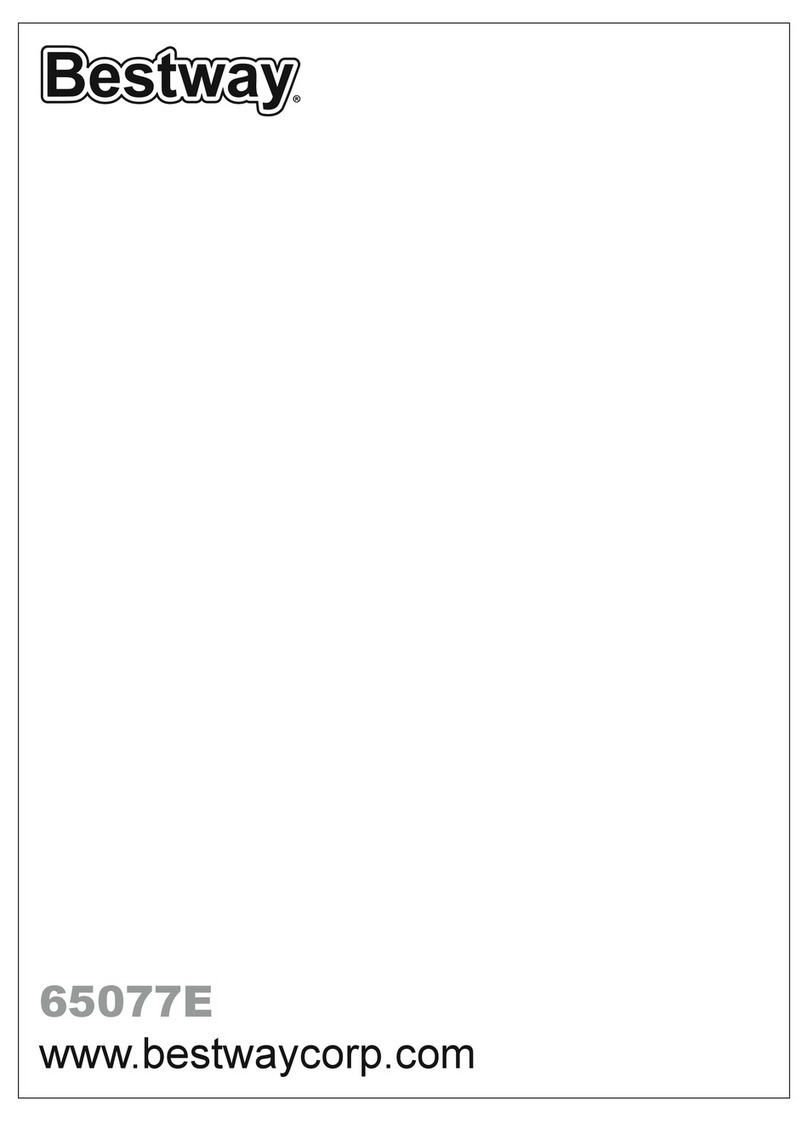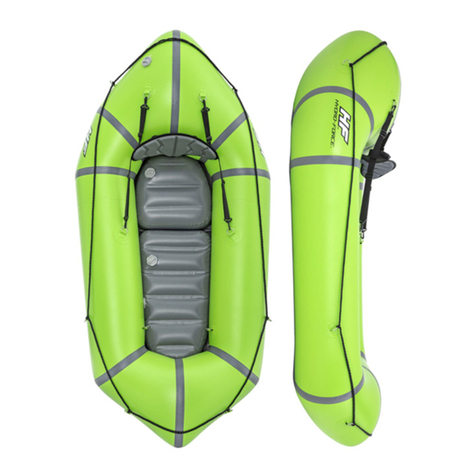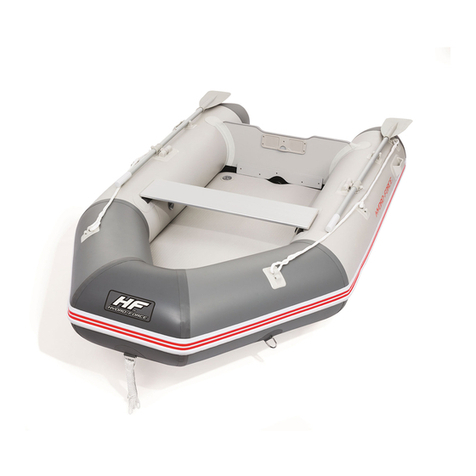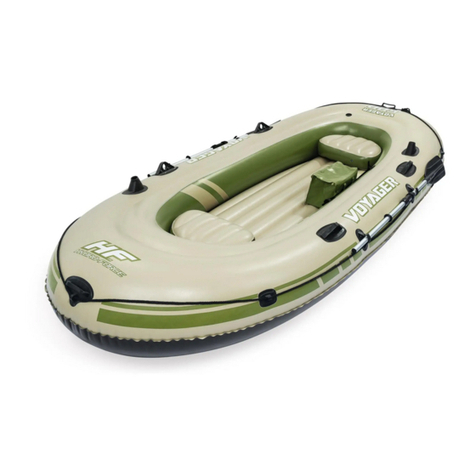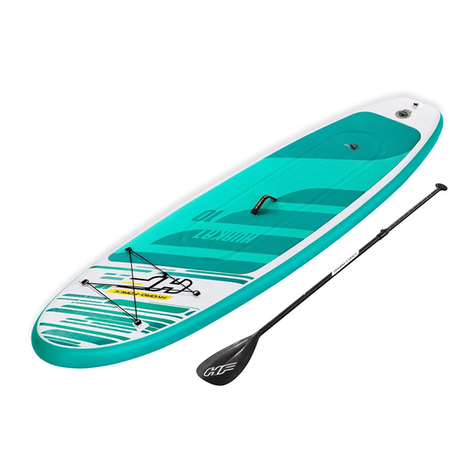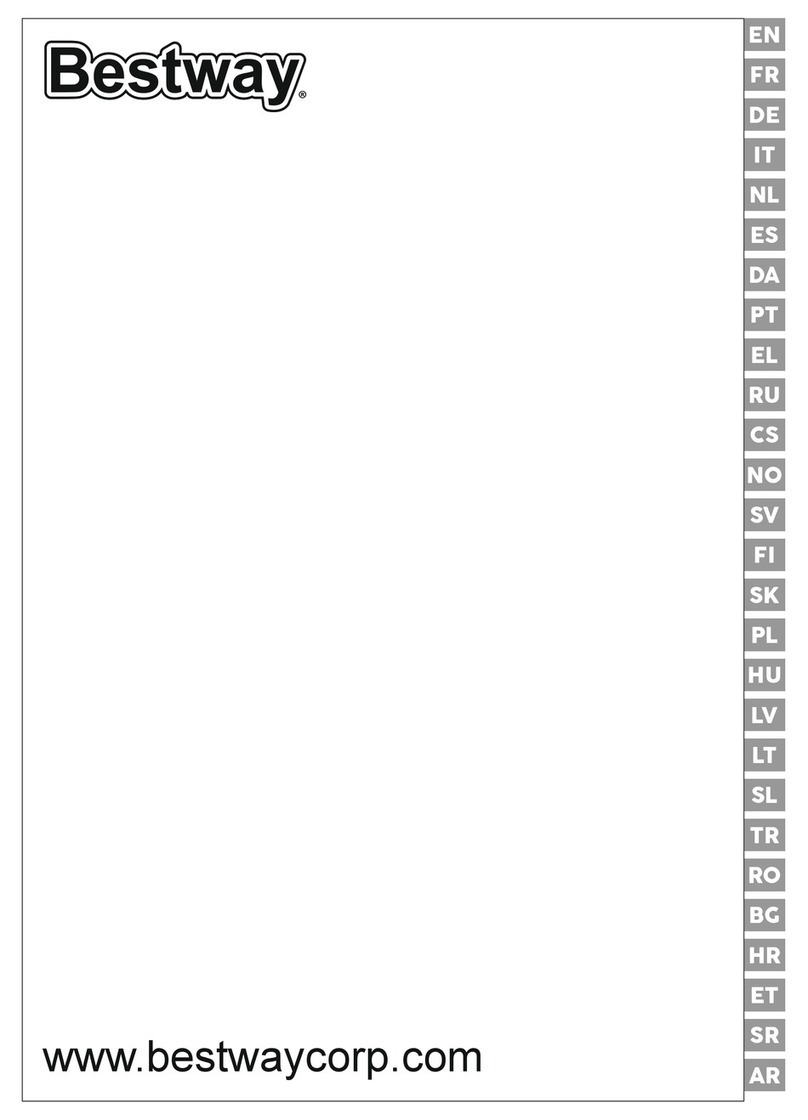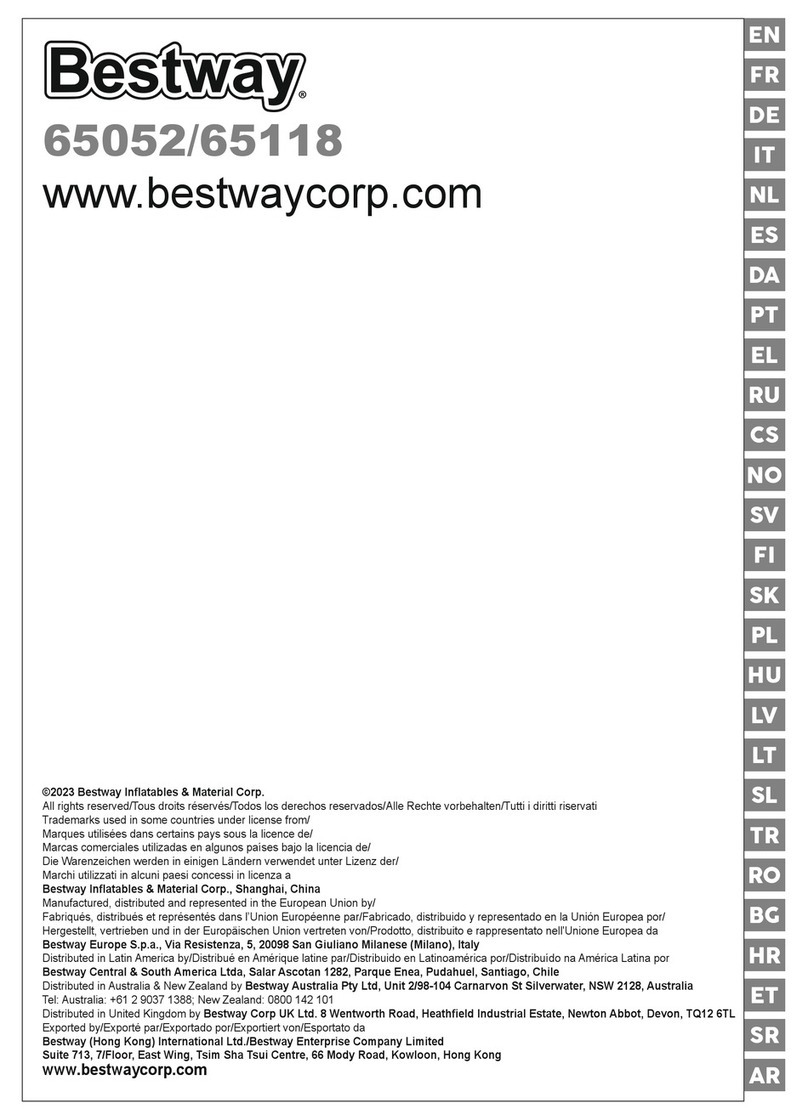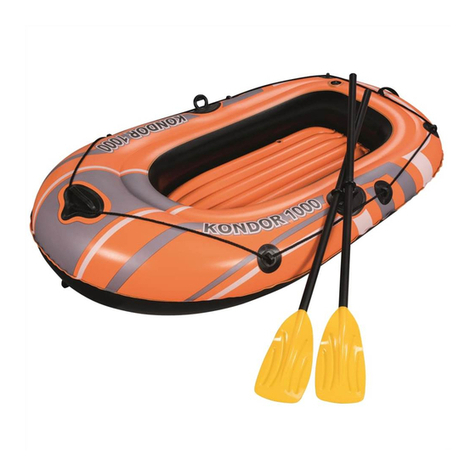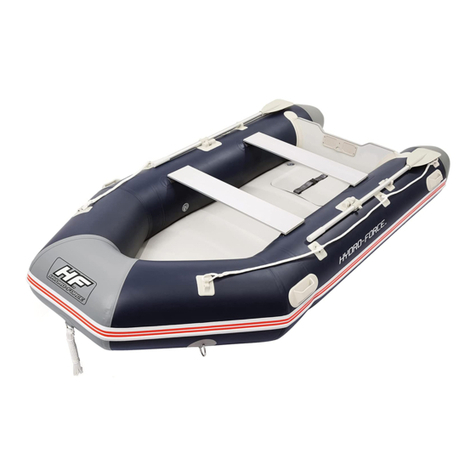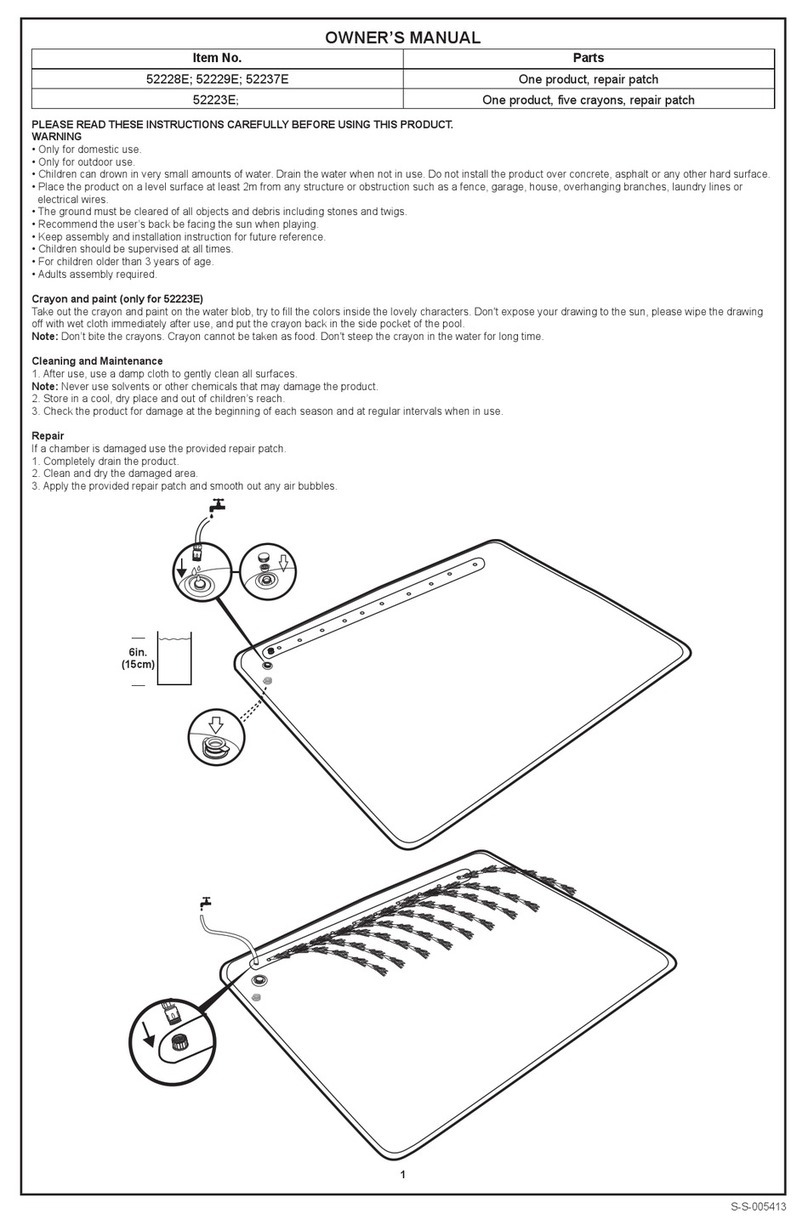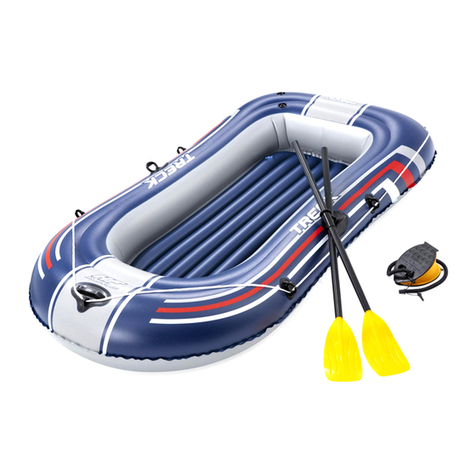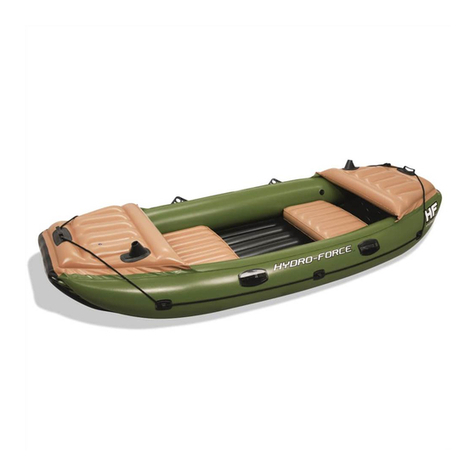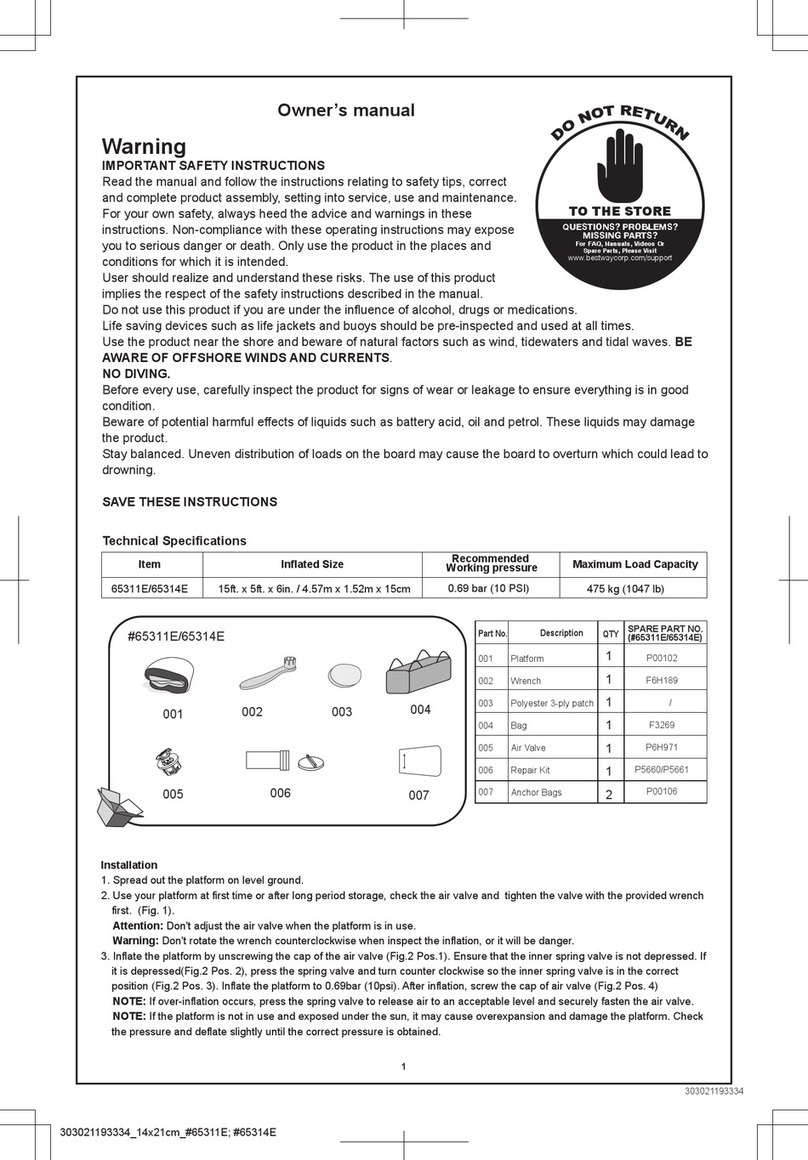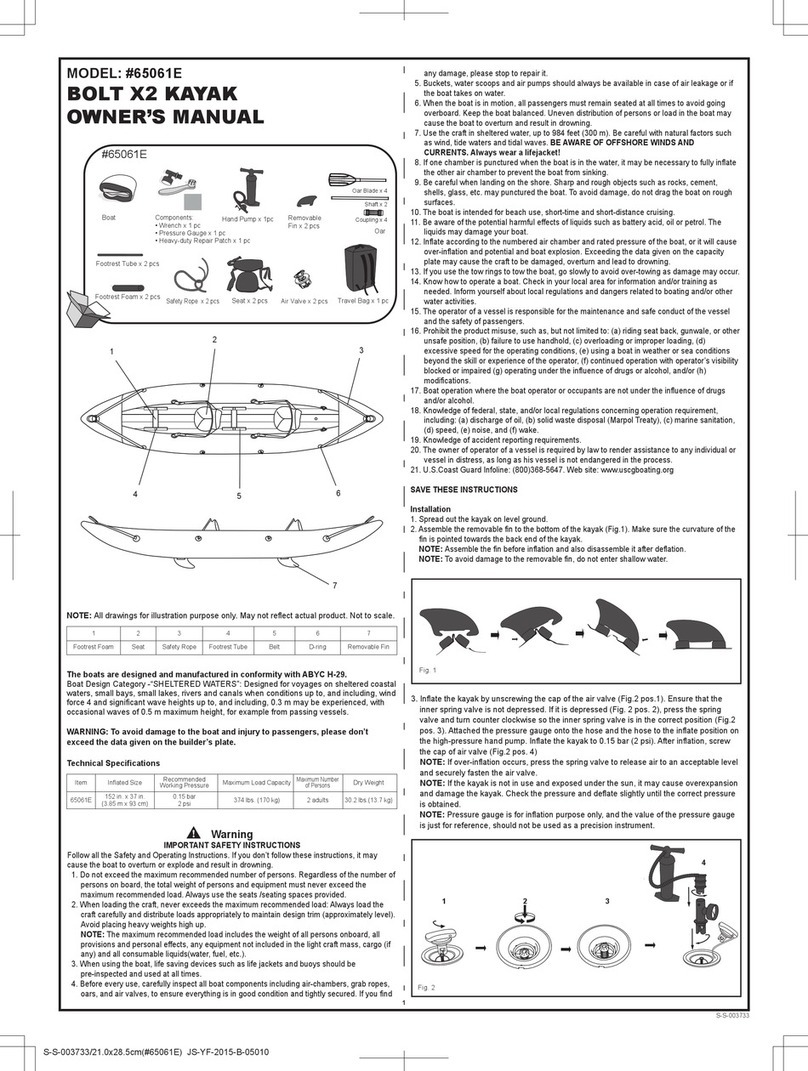
2
7
41
2
3
5
6
65052E
1 2 3 4 5 6 7
D-buckle Buckle Velcro oar band Handle Storage bag Seat Safety rope
Technical Specifications
Item
65052E
Inflated Size Recommended
working pressure
0.06 bar (0.8 psi)
Maximum
load capacity
440 Ibs. (200 kg)
Maximum number
of persons
2 adults
Dry Weight
10 ft.10 in. x 34 in.
3.30 m x 86 cm
31.72 Ibs.
(14.38 kg)
Technical Specifications
Item
65118E
Inflated Size Recommended
working pressure
0.06 bar (0.8 psi)
Maximum
load capacity
286 Ibs. (130 kg)
Maximum number
of persons
1 adult
Dry Weight
9 ft. 2 in. x 34 in.
2.80 m x 86 cm
25.18 Ibs.
(11.42 kg)
Construction of the boat
NOTE: All drawings for illustration purpose only. May not reflect actual product.
Not to scale.
1 2 3 4 5 6 7
D-buckle Buckle Velcro oar band Handle Storage bag Seat Safety rope
The boats are designed and manufactured in conformity with ABYC H-29.
Boat Design Category -“SHELTERED WATERS”: Designed for voyages on sheltered coastal waters,
small bays, small lakes, rivers and canals when conditions up to, and including, wind force 4 and
significant wave heights up to, and including, 0.3m may be experienced, with occasional waves of
0.5m maximum height, for example from passing vessels.
WARNING: To avoid damage to the boat and injury to passengers, please don’t exceed the
data given on the builder’s plate.
WARNING
IMPORTANT SAFETY INSTRUCTIONS
Follow all the Safety and Operating Instructions. If you don’t follow these instructions, it may cause
the boat to overturn or explode and result in drowning.
1. Do not exceed the maximum recommended number of persons. Regardless of the number of
persons on board, the total weight of persons and equipment must never exceed the maximum
recommended load. Always use the seats /seating spaces provided.
2. When loading the craft, never exceed the maximum recommended load: Always load the craft
carefully and distribute loads appropriately to maintain design trim (approximately level). Avoid
placing heavy weights high up.
NOTE: The maximum recommended load includes the weight of all persons onboard, all
provisions and personal effects, any equipment not included in the light craft mass, cargo (if
any) and all consumable liquids (water, fuel, etc.).
3. When using the boat, life saving devices such as life jackets and buoys should be pre-inspected
and used at all times.
4. Before every use, carefully inspect all boat components including air-chambers, grab ropes,
oars, and air valves, to ensure everything is in good condition and tightly secured. If you find any
damage, please stop to repair it.
5. Buckets, water scoops and air pumps should always be available in case of air leakage or if the
boat takes on water.
6. When the boat is in motion, all passengers must remain seated at all times to avoid falling
overboard. Keep the boat balanced. Uneven distribution of persons or load in the boat may
cause the boat to overturn and result in drowning.
7. Use the craft in sheltered water, up to 300m (984 feet). Be careful with natural factors such as
wind, tide waters and tidal waves. BE AWARE OF OFFSHORE WINDS AND CURRENTS.
Always wear a lifejacket!
8. If one chamber is punctured when the boat is in the water, it may be necessary to fully inflate the
other air chamber to prevent the boat from sinking.
9. Be careful when landing on the shore. Sharp and rough objects such as rocks, cement, shells,
glass, etc. may puncture the boat. To avoid damage, do not drag the boat on rough surfaces.
10. The boat is intended for beach use, short-time and short-distance cruising.
11. Be aware of the potential harmful effects of liquids such as battery acid, oil or petrol. The liquids
may damage your boat.
12. Inflate according to the numbered air chamber and rated pressure of the boat, or it will cause
over-inflation potential and boat explosion. Exceeding the data given on the capacity plate may
cause the craft to be damaged, overturn and lead to drowning.
13. If you use the tow rings to tow the boat, go slowly to avoid over-towing as damage may occur.
14. Know how to operate a boat. Check in your local area for information and/or training as needed.
Inform yourself about local regulations and dangers related to boating and/or other water
activities.
15. The operator of a vessel is responsible for the maintenance and safe conduct of the vessel and
the safety of passengers.
16. Prohibit the product misuse, such as, but not limited to: (a) riding seat back, gunwale, or other
unsafe position, (b) failure to use handhold, (c) overloading or improper loading, (d) excessive
speed for the operating conditions, (e) using a boat in weather or sea conditions beyond the skill
or experience of the operator, (f) continued operation with operator’s visibility blocked or
impaired (g) operating under the influence of drugs or alcohol, and/or (h) modifications.
17. Boat operation where the boat operator or occupants are not under the influence of drugs and/or
alcohol.
18. Knowledge of federal, state, and/or local regulations concerning operation requirement,
including: (a) discharge of oil, (b) solid waste disposal (Marpol Treaty), (c) marine sanitation,
(d) speed, (e) noise, and (f) wake
19. Knowledge of accident reporting requirements.
20. The owner of operator of a vessel is required by law to render assistance to any individual or
vessel in distress, as long as his vessel is not endangered in the process.
21. U.S.Coast Guard Infoline: (800)368-5647. Web site: www.uscgboating.org
65118E
7
41
2
3
5
6
VENTURA KAYAK
Boat
Components:
• Repair Patch
• Deflation Pipe
Storage Bag
Oar Blade x 4
Shaft x 2
Coupling x4
Removable Fin x 2
Seat x 2
Screw Valve x 3
Footrest Cushion
Hand Pump
Safety Rope
Inflation Scale
Oar
Boat
Components:
• Repair Patch
• Deflation Pipe
Storage Bag
Oar Blade x 2
Shaft x 1
Coupling x 2
Removable Fin x 2
Seat x 1
Screw Valve x 3
Footrest Cushion
Hand Pump
Safety Rope
Inflation Scale
Oar
